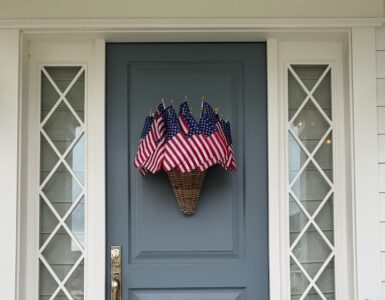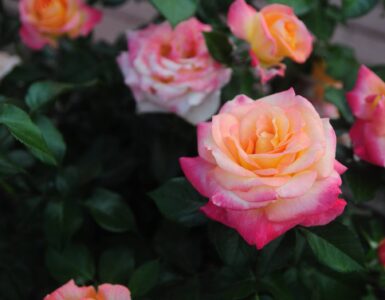Professional organizer Kelly Pratt shares her tips for getting and keeping your entryways free of clutter.
Entryways Are Tricky
Entryways are tricky organizing areas because they are high-traffic areas where many people and things movie in and out. Add the element that this is where guests enter your home, and you have a high-traffic area that needs to be kept fairly consistently under control. Who wants the first thing that meets you at the end of the day to be a colossal mess? Who relishes apologizing to guests as you kick shoes and dirty socks out of the way as you open the door?
If your entry area is separate from the main flow of your home, there’s even more of a temptation to leave this area an untamed conglomeration of stuff. But just because no one sees the clutter doesn’t mean it doesn’t wreak havoc on daily functioning; you’re just lucky that no one sees it. Regardless of your entry’s placement in your home, If you don’t know what needs to go into—or stay out of—your entry, or if you don’t have a good upkeep system, your entry can quickly devolve into a dumping ground for everything from shoes to unopened mail.
Which Purposes Does Your Entry Serve?
Depending on your organizing style and the size of your home, your entry can serve a number of different functions. As you consider your entry, ask yourself which activities typically launch from this area. What do you need to store here to help you get out the door? Which areas do you need to establish so you can put things away when you get home? You might need homes for the following items:
• Coat and cold-weather accessories
• Sunglasses
• Mail
• Message centers
• Out-the-door lists
• Returns
• Keys
• Backpacks
• Purses
• Diaper bags
•Shoes
•Cameras
•Sports equipment
• Cleaning supplies
• Pet supplies
Add or Remove Items to Achieve Your Purpose
Be specific as you determine what absolutely must be kept in your entry to ensure your household functions smoothly. Once you determine what your entry’s function is, you can set about to remove items that don’t serve its intended purpose and to order the things that need to live there. Most homes have limited space for entry areas. Be ruthless in removing items that don’t belong.
Create Good Locations, Good Containing and a System for Upkeep
Many of the problems with stuff being piled in entryways are due to a few causes:
• Items don’t have consistent homes.
• The homes for much-used items are inconvenient.
• Containing is either bulky or non-existent.
• There isn’t a system for upkeep.
Let’s address these issues one by one.
Good Location
The number-one rule of real estate and organizing is location, location, location! Think of any disorganized area of your home. 9 times out of 10, your problems are caused by not having specific homes for your stuff. As you organize your entry area, put your most-used items where you can access them most easily, and keep like items together or grouped by person: Emma has her own container or hook, Josh has his own, etc. If you have small children whom you wish to help with upkeep or want to teach to put things away, put their belongings where they can be reached.
Good Containing
To make your containing effective, consider these guidelines:
• Use containers that suit the items you are containing. For example, if you are storing heavy items, use rigid containers that won’t sag under their weight.
• Minimize or eliminate horizontal surfaces. Especially in entries, horizontal surfaces are clutter magnets. If you have a bench in your entry, consider how often you actually sit on the bench to put on your shoes as opposed to how often the bench fills up with a little bit of everything. Unless you are very disciplined or the bench is in a secondary entrance, you may want to consider other seating or storage options.
• Make sure containers are functional as well as good looking.
• Use smaller rather than larger containers. Especially if you are storing items on high shelves or have small children who may need to access containers, smaller containers are more accessible and easier to use.
• Use containers that will help you make use of wasted space. Some of these containers are listed below.
Some of my favorite containers for entries are—
• Stuff sacks—Available at big box stores, outdoor goods retailers and online. Stuff sacks are great for storing gloves, scarves and hats. You can use a different color for each member of the family and store them in a larger basket or bin or on hooks.
• Hooks—Available at big box stores, home improvement warehouses and online. Hooks are probably the most versatile of all storage options for entryways, particularly if you have young children. Hooks are, hands down, the most accessible storage option for backpacks, coats, purses, diaper bags, etc.
• Plastic drawers—Available at big box stores. Plastic drawers allow you to use the often-wasted floor space of entry closets and can be used to store items by category (scarves, gloves, hats) or to hold items for each member of the household.
• Mesh cubes—Available at www.containerstore.com, these cubes are fantastic for returns and to hold items for individual family members. You might use mesh cubes to hold each person’s shoes, winter gear stuff sack, sports equipment, etc. Mesh cubes are also somewhat transparent, so you can see what’s inside without emptying the contents.
• Hanging sweater dividers with or without drawers—Available at IKEA, big box retailers, and online. Hanging dividers take advantage of unused closet space and can be used to hold everything from cold-weather gear to cleaning and pet supplies. You might want to assign a spot to each member of the family.
• Jelly roll pans and cooling racks—available at big box retailers. This combination is particularly fantastic to hold messy winter boots while the snow melts off. Place a cooling rack inside of a jelly roll pan to keep boots elevated above the puddles that form below.
System for Upkeep
Determine how often you will clutter-clear your entry area. Your frequency will be affected by variables like how many people are in your household, where your main entry area is located and how many purposes your entry area serves. If you have a number of household members, use your common entry as your guest entry, or have a multi-purpose entry, you may want to do clutter control a couple of times a day rather than a couple of times a week.
I hope that implementing some of these ideas will help you create a beautiful, functional entry and say goodbye to the resident obstacle course!
Happy organizing!
Kelly
elly@spaceslimitedorganizing.com
www.spaceslimitedorganizing.com















Add comment